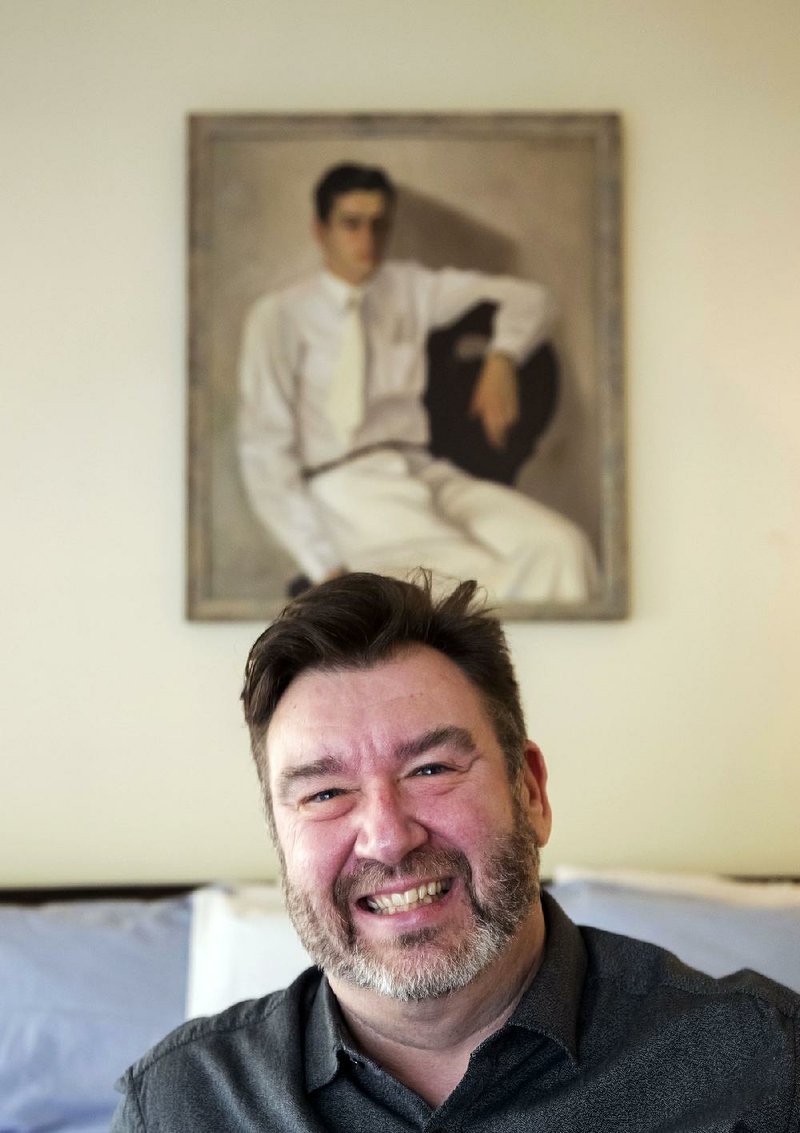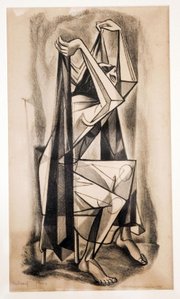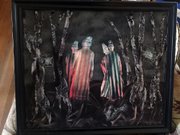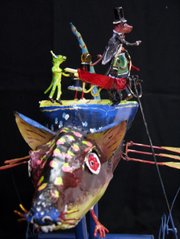It's an art lover's fantasy: finding a valuable work of art at a paint-by-number, thrift-store price.
As one prowls estate and garage sales, antique and resale shops, auctions and flea markets, visions of an Antiques Roadshow triumph tantalize the imagination.
There are bargains in what is known as the secondary art market, places that sell previously owned works, some of which were originally purchased from galleries or artists. The wares range from fine to not-so-fine art, mass-produced prints and homemade pieces worth a few dollars to original paintings and sculptures that can bring thousands.
"The idea of finding a masterpiece is intriguing, but it's a long shot at best," says Brad Cushman, gallery director and curator at the University of Arkansas at Little Rock.
"People use the word 'art' very loosely," says Roy Dudley of Roy Dudley Estate Sales. "I get three to five calls a day from people who think they've found an Old Master work or something valuable. For every 100 I see, there's one that's valuable. That's the part of my job I don't enjoy ... telling people their art isn't as wonderful as they think it is."
Cushman says the secondary marketplace "can be a source of good art, though there's a lot of bad stuff, too. But beauty and art are in the eye of the beholder, and someone with an eclectic personality might have more luck."
Someone, say, like Amanda Linn of Little Rock.
"Most of what we have may not be what many people would consider fine art or even art," says Linn, who works in adult leadership development at the Arkansas Leadership Academy.
Linn, an artist and former art teacher, and her wife, Barbara Hall, are enthusiastic collectors of everything from student art to folk art and quirky pieces by unknown artists.
"We forage for art," Linn says. "Our taste runs toward outsider art. Our bedroom is floor-to-ceiling portraits; the weirder it is, the better for us. Most of what we have are modestly priced pieces."
Little Rock is a thriving secondary-art market, says Dudley.
"Art is significantly less expensive [in the secondary market]," he says. A licensed and certified personal property appraiser specializing in antiques, Dudley sells a lot of art, primarily vintage pieces, through his showroom at the Tanglewood Shopping Center at Mississippi Street and Cantrell Road in Little Rock.
"Little Rock is a very sophisticated market for vintage art," he says. "There is a resurgence of interest in 20th-century regional artists in Arkansas, which is the opposite of the national trend. Arkansans such as Adrian Brewer, Louis and Elsie Freund, M.S. (Maud ) Holt. Our customers expect to see vintage Arkansas, works by deceased artists or those who no longer create art."
Dudley recently sold a Brewer painting for $18,000.
But Dudley's business also reflects the range of this market -- he's sold pieces for less than $5.
PASSIONATE PURCHASERS
Don Edwards of Little Rock has acquired most of his collection at estate sales and auctions.
"I bought my first piece of art at age 18; I've been collecting almost 50 years," he says. "I've paid from $3 to just under $2,000 for a piece of art."
Edwards' main interest is Eureka Springs artist Miriam McKinnie, who also painted murals in the 1940s. He focuses on 20th-century American art and portraits.
"I have a lot from the 1930s through the 1950s and into the 1960s," he says. Edwards is retired and works part time for Dudley on sale weekends.
Along with a passion for art, Edwards and Linn share another reality -- art is everywhere in their homes.
"It's ceiling-to-floor, wall-to-wall, in closets and under the bed," Edwards says.
Linn says that's her decorating scheme too. "We love estate sales and flea markets ... our house kinda looks like a flea market," she says, laughing.
Edwards thins his collection periodically, selling at auctions or resale markets.
"I think a lot of people start their art collection in the secondary market," says John Bell of Sweet Home Furnishings/Clement, 1324 S. Main St. in Little Rock. The store builds its stock of Americana-flavored furniture, collectibles, decorator items and art from Bell and business partner Chris Clement's travels around the region visiting flea markets, estate sales and more.
"It's smart, even with contemporary art, to buy what you like. If you buy for investment, your collection is pretty soulless," Bell says. "You start with what speaks to you ... who knows where it will lead you?"
It might lead you to a thrift store. The website apartmenttherapy.com posted a short article on ways to update thrift-store art, including painting over a cheap print to give it a paint-by-number vibe or adding monsters or aliens to enliven an otherwise boring landscape.
ON THE WEB
"I think people are a little wary about buying art online," Edwards says. "I've not had a lot of luck selling art online, but I've bought art there and gotten some real bargains, including three George Platt Lynes photographs."
A cellphone can be an art lover's best friend. If you're at a sale or a preview of artworks about to be auctioned and see an artist's name you don't recognize, do an online search with your phone, says auctioneer John Saugey of Pinnacle Auction and Estate Service, 4621 Asher Ave. in Little Rock.
Knowledge makes a better-informed buyer, Dudley says.
"Prior to the internet, I would have to get into a book to find information on prices or to authenticate a work. Now I just go to my computer and search for the information. The internet makes art collections faster to build."
"If a purchase impacts your budget, research it," Edwards says. "I wouldn't pay a lot of money for a piece I don't know a lot about. I've bought a few that were unsigned, but I didn't pay a lot."
"The internet has really broadened our reach," says John Williams of The Good Stuff Auction, 7824 Colonel Glenn Road in Little Rock. "We post our auctions and photos on our website, and we'll get calls sometimes from as far away as Europe."
Along with classified listings in the Arkansas Democrat-Gazette, other places to find information on sales include the websites of auction houses, estate sale firms and some flea markets or antique malls.
"One of my resources is ashleysfinds.com," Edwards says. "They send an email weekly with some good prospects for estate sales."
FAVORITES AND BARGAINS
Cushman was excited to find a sculpture by Bill Reid at a Dudley estate sale.
"It was from the Susan Pfeifer estate, a whimsical toy piece titled S.S. Ratship. We had exhibited it at UALR, and I was happy to get it. It would have cost me two or three times more at a gallery."
Renee Williams, owner of Gallery 26 in Little Rock, couldn't resist a drawing she found at an antique mall.
"I paid $100 for a pencil drawing of a goddess-type figure by Bruno Surdo. It was worth a lot to me before I found out what it was really worth."
Dudley's prize art possession is a painting by Thomas Robertson, artist-in-residence at UALR in the 1940s. "It wasn't a bargain, but it spoke to me, and I had to have it. It was painted in New Orleans in the 1930s. It is so beautiful; it spoke to me. It hangs over my bed."
Three of Robertson's works are in the Smithsonian American Art Museum collection. Dudley has since acquired other Robertson works, including a landscape he bought for about $60.
Linn doesn't recall the exact price she paid, but it was just over $100 each, for circular portraits of Liza Minnelli and Burt Reynolds she says are about 3 feet tall.
"They took our breath away," Linn says. "They may have come from a dinner theater; there were four of them. We only had room for two, so we had to leave Elizabeth Taylor and Robert Redford behind. Liza and Burt are the anchors of our portrait collection."
...
Just because the house is overflowing with art doesn't mean the search ends.
"Keep your eyes tuned," Dudley says. "Incredible things will appear."
"We're sold on looking for that next great piece," says Linn.
Style on 11/13/2016





